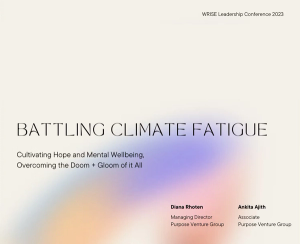Back to Latest

With Q1 2025 already in the rearview mirror, we asked PVG’s partners how they are thinking about some of their favorite topics—with a focus on climate finance and capital markets, philanthropic support of climate initiatives and the transition to electric vehicles.
Tony Curnes on Climate Finance and Capital Markets
What is the biggest roadblock the climate finance space faces over the next year as it relates to advancing climate goals?
Much of my perspective comes from conversations we've had with investment firms and our work with clients and companies in the space.
There are three main things that I would point to: First, disappointing exits—venture investors are always looking at what the exit environment is like for the sectors and companies they're investing in. And we saw, over the last couple of years, a downturn in SPACs as a viable exit opportunity, which certainly doesn’t help the issue. Second, we saw interest rates rise—this disproportionately hurts climate tech companies that are reliant on long-duration funding for capex-intensive projects. Third, more recently, we've seen a change in administration which has said that it is not supportive of government investment in the climate tech space, which is something that the sector had been growing to count on under the Biden administration.
Also, climate tech companies, by nature, have not necessarily always had to prioritize profitability and scaling profitably. They've been encouraged to focus on scaling quickly rather than profitably. And so we're seeing a shift in the space, which should be healthy over the medium term. PVG has already seen this as we’ve worked with climate tech companies that had to pivot their strategies, sometimes materially, in order to secure funding in this new environment.
This CREO survey definitely captured key themes and is a great resource for people who want to learn more.
Is there a climate finance milestone you would like to see achieved by the end of 2025?
The metric that I'm looking at most closely is the extent to which new rounds are being led by new investors versus existing investors.
Something that we've seen happening in this space over the last couple of years is a lot of additional funding rounds being led by the existing investor base that is looking to protect their investments. And as soon as we start to see a return to investors willing to take bets on companies that are new to their portfolio, that will likely be the indicator that the space has returned to some degree of health.
Is there a company that you’re most excited about this year?
Rondo Energy—we helped them prepare for a successful fundraise last year. Their product is thermal energy storage; it's a great solution that allows clean power to fuel industrial processes that are typically fossil fuel-intensive. The long-duration electrical and thermal energy storage space has seen a lot of investment and several companies could emerge as winners, but Rondo is one that we think is a standout and is a climate tech company that is well-positioned for this shift towards scaling profitably.
Diana Rhoten on Climate and Philanthropic Funding
What is the biggest roadblock that foundations face over the next year as it relates to advancing climate goals?
Federal disengagement is happening on multiple dimensions of social change that foundations care about, and this presents a real battle of priorities and a strain on funding. I'm of the mind that foundations are going to step in to the extent that they can, but the reality is that philanthropic capital can't fill all the gaps that federal disengagement will create.
How does a foundation solve the issue of competing priorities?
There are different tactics to take. If I were a large-scale national foundation, I would try to build a coalition of funders to multiply my impact. I would be very focused on finding projects and programs that have the greatest nonpartisan value and can have the greatest economic and environmental impact. As an example, I might look to do something like the Founders Pledge Climate Fund is doing. They conducted a range of research and, in January, announced that backstopping shortfalls in LPO funding fit the multiple criteria of filling a federal gap, serving a nonpartisan concern, and promising the greatest impact.
If I were a community foundation, I would be focused on state and local efforts. I would try to do something similar to what Bloomberg Philanthropies did at the international level in 2017 to fill the US financial gap that existed when we withdrew from the Paris Climate but at the state and community level. I think we'll see that kind of local climate activation and action from community foundations.
If I were a family office, I would be thinking about how to drive private capital into the markets. We're already seeing VC and PE investors starting to hedge their bets, because some of the market growth and investment return opportunities they expected to see, which were facilitated by federal incentives, are no longer in the market. Using their concessionary capital, family offices have an ability to support some of the decarbonizing ventures we really need in the world until the market stabilizes.
Is there a climate philanthropy milestone you would like to see achieved by the end of 2025?
I'm gonna reveal my bias, but so much time, energy, commitment, investment, intellect, sweat and tears from so many people went into making the GGRF policies a reality. To erase all that hard work and potential impact for low-income communities is really devastating. I’m a big believer in collaborative funding models, so I would like to see coalitions come together to protect GGRF.
You could argue that if these GRRF projects don't get fulfilled and organizations fall behind on work plans, it creates problems in other priority areas for foundations, right?
Definitely—for example, Americans’ cost of living can’t go down without interventions that can reduce energy costs, improve health outcomes, and de-risk housing structures. Without the types of GGRF activities that will address some of these social and economic issues as well as climate concerns, foundations have to solve them.
Is there an organization that you’re most excited about this year?
I really admire Renaissance Philanthropy—their work is largely (but not only) focused on AI-related topics,but I would love to see them join us in the climate space.
Nadeem Sheikh on the Transition to Electric Vehicles
What is the biggest roadblock that EV technology and companies face over the next year as it relates to advancing climate goals?
Simply put, I think there’s still a lack of compelling products for the mass market consumer. I think the average American consumer looks at an EV and says that it’s just too expensive and isn't differentiated enough to make them want to try something new.
Trump is in the process of instituting trade barriers that will make it more difficult for Chinese EV makers to enter the US market but we will not be able to keep them out of the US forever. [QUOTE] The fact is that car manufacturing is a global game, not a national one. If America wishes to continue to have an auto industry that does not need to be subsidized or heavily protected by our government, the industry must, in the next five years, meet the Chinese on price, quality and innovation. US, European, and Asian OEMs are going to innovate or die. While we scramble to catch up, the Chinese OEMs continue to run very fast, frequently announcing new innovations related to EV charging and other supporting technologies like autonomy. They’re not betting on electrification primarily due to environmental reasons - electrification is cheaper, cleaner, and better than fossil fuel alternatives and OEMs that position themselves with the best electric products will win the market in the long run
I remember reading an article for months in Detroit didn’t want to give it up. Farley said “executing to a Chinese standard is going to be the most important priority,” and dubbed them an “existential threat.” I hope I’m wrong, but I think it's going to be extremely hard for US automakers or even the Japanese or Europeans to compete in the long run because Chinese manufacturers also enjoy government support and the freedom to innovate rather than prioritize profits in the short-term.
In terms of milestones for the next year, what do you want to see?
One thing I would love to see is more announcements from major automakers in the US market that offer products that Americans are asking for. We know Americans value freedom of movement and we know that the affordability of new cars is an increasing challenge for many households , so the US, European, and Japanese OEMs need to address range anxiety and deliver a lower-priced EV.
Chinese automakers are, again, the place to look for this. Their manufacturers have perfected the Extended Range Electric Vehicle (EREV) on a mass scale—a car with a small generator and gas reserve on board solely for charging the battery to extend its range. How far can you go on a full tank of gas and electricity in a Chinese EREV? 1000 miles. The average daily trip for an American is ~30-50 miles. An EREV has a battery with ~200 miles of range. So more than 90% of the driving is done electric, and okay, once in a while, you use the gas reserve.
Two American companies are beginning to enter this product category. Scout, a US division of Volkswagen, is a new EV brand launching in 2026 that is doing this and the majority of their pre-orders are for their EREV, so it's clearly appealing to American buyers. Ram is also going to introduce a EREV heavy duty pickup truck in 2025.
Is there a company in your space that you’re most excited about this year?
Related to my comment about Scout I’m most interested in watching how the partnership between Rivian and Volkswagen develops. Volkswagen just announced a new car for Europe, under $20,000 that looks like a Rivian. I think German hardware engineering, plus American software innovation, can deliver something compelling at a global scale.

